Welcome and thank you for visiting my blog!
After my return from vacation, I was very pleased to see so many messages on the blog regarding the motu proprio. We couldn’t post all of them but it was interesting to see people’s reactions, and the interest in the motu proprio. I think it only underscores the wisdom of the Holy Father’s approach to people’s liturgical preferences.
I continue to echo the Holy Father’s desire that the liturgy not be the battleground but be a source of unity for all of us. We must love the Mass in all of its different manifestations. Our Latin rite is a very beautiful ancient rite, and we need to grow in appreciation of its history and also in its ongoing history.
Additionally, I am confident that the difficulties concerning the prayers that might be considered offensive to the Jewish community will be resolved. I know that Cardinal Francis Arinze, prefect of the Congregation for Divine Worship, is even contemplating the possibility of trying to harmonize the calendars of the former liturgy with the Norvus Ordo.
– – –
On Tuesday, I met with Bishop Simon Stock Palathara of the Diocese of Jagdalpur in the northern, tribal parts of India.
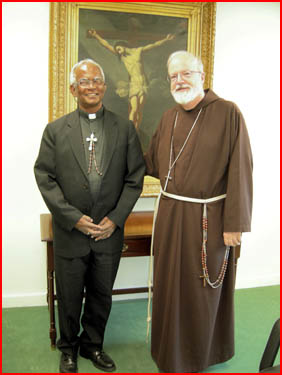
Bishop Stock and I in my offices
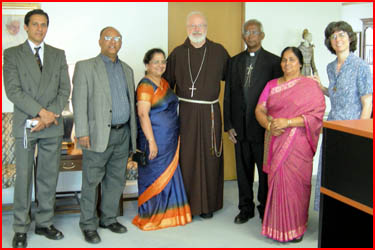
Representatives from the Boston Syro-Malabar community and our coordinator for Ethnic Ministries, Sister Mary Corripio, (on the right) join us for a photo
Bishop Stock belongs to the Syro-Malabar rite, which I understand, after the Maronites, is the largest oriental rite in the Catholic Church, and of course, they trace their roots to St. Thomas the Apostle. It is a very ancient rite in the Church and is very strong in Kerala, India where the bishop is from. He has relatives in our diocese who are very active with the Syro-Malabar Catholics here. Last year I celebrated the Mass for the feast of St. Thomas, their special patron, and this year Bishop Walter Edyvean celebrated the Mass held at St. Jude Church in Waltham.
I would like to share some of the scenes of the celebration with you.
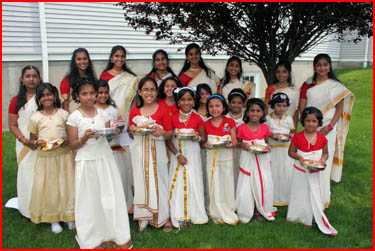
Children dressed in traditional Malabar dress, with flowers and a lamp in their hands, wait to receive the bishop
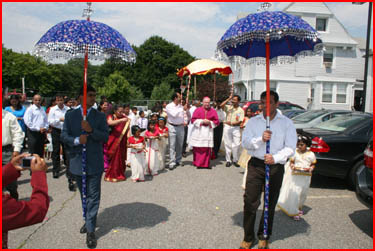
Bishop Edyvean being solemnly received with “Thalappoli” (virgins dressed in traditional Malabar style clothing, carrying flowers and a burning lamp) and “Muttukkuda” (decorative umbrellas used in religious processions, unique to the Syro-Malabar Church)
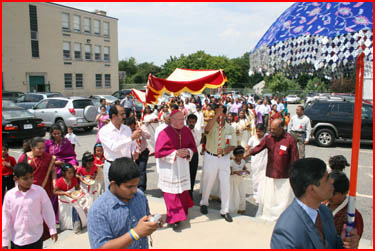
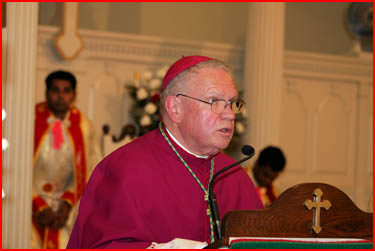
Bishop Edyvean delivers his homily

Offertory procession of flowers, fruits, candles, Bible, bread and wine
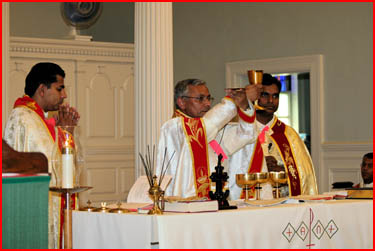
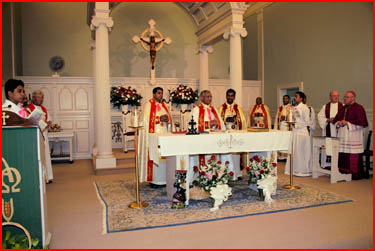
Bishop Edyvean presiding at Mass. The celebrants were Fathers Kuriakose Vadana, Baiju Avittappallil, Joshy Paramthottu, Frank Silva, Cyriac Mattathilanickal, Tom Vallamattam, William Kaliyadan and John Karuvelil
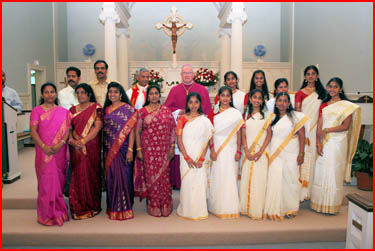
The choir with Bishop Edyvean
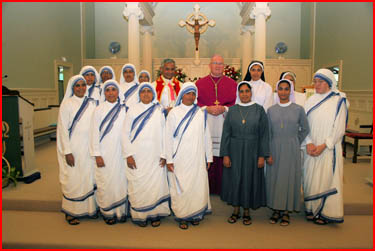
Religious sisters belonging to the Syro-Malabar rite working in the Boston area. The majority of the Missionaries of Charity Sisters come from the Syro-Malabar Rite Catholics
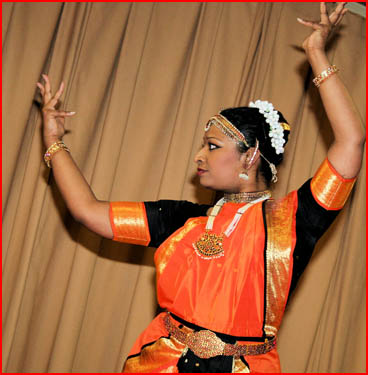
Soumya Johnson presents a classical Indian dance
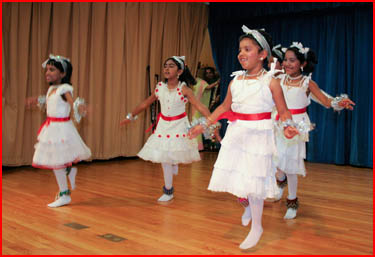
Little Flower Mission League children perform dances
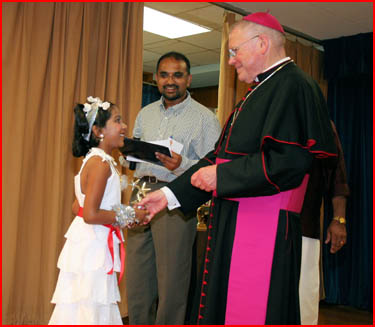
Trophy for perfect attendance at religious education classes is presented to Blessy Varghese
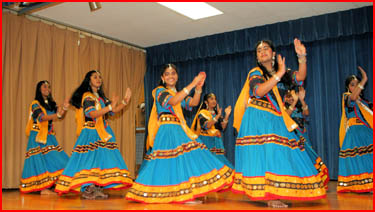
Jesus Youth present an Indian folk dance
The bishop did say that often times there is persecution of the Church, even in the tribal areas where more and more people are coming to Christianity. Their coming is provoking a reaction from the nationalists and the Hindus who resent that. But the Church in India has grown strong, and many of the religious communities and diocese in India that are blessed with many vocations are participating in the mission ad gentes. In my own community, we have help from India with our mission in Papua, New Guinea. They are also helping in Zimbabwe and in other parts of Africa. Many people think of India as a mission country, but actually it is a country that now has many vocations and is supporting many missions.
– – –
On Wednesday I visited Old Colony Correctional Center and Bridgewater State Hospital where there are actually four facilities that make up one compound.
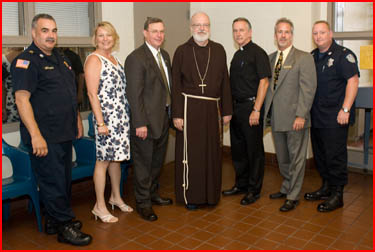
Capt. Paul Gordon, director of classifications Carol Lawton, Dep. Superintendent Mark Powers, Deacon Monroe, Superintendent Steven O’Brien and Lt. Doug Bower of Old Colony Correctional Facility join me for a photo
We had a prayer service at one of the facilities, organized by chaplain Deacon Richard Monroe. They had a fantastic choir and a group of musicians who played at the bilingual service. The singing was extraordinary.
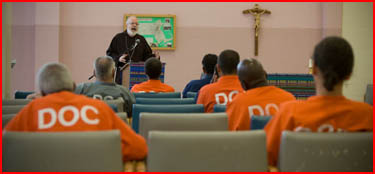
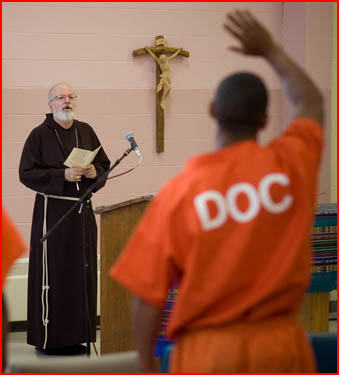
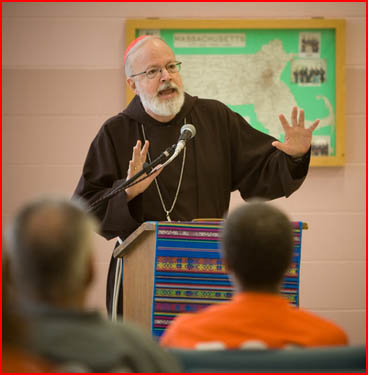
I visited the cell blocks there as well. In particular, I tried to visit those who are in solitary confinement.
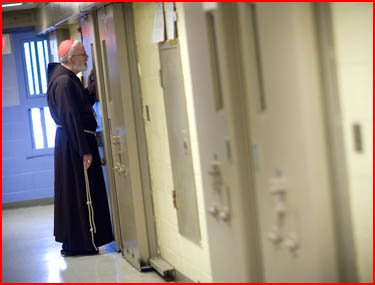
From there I went to Bridgewater State Hospital and met with the staff and a number of the patients there. I was very moved by the situation in the hospital where some very sick people with mental problems live. Obviously, their mental problems have brought them into conflicts with the law. We had Mass in the auditorium for the patients and there must have been 150-200 people there. Peg Newman, the hospital’s chaplain, organized the Mass and did a wonderful job.
Superintendent Karin Bergeron was very impressive and compassionate. We also met Judge Minehan who works there. One of her assignments from the courts is to determine when people are liable for judgment or whether their mental capacity is such that they cannot be held fully responsible.
In the past, I found myself critical of how difficult it is for us in the United States to commit mentally ill people to institutions where they will get proper care. I was in Washington, D.C. when the Supreme Court ruled that no one could be held against their will unless they were deemed dangerous. That was, in some ways, the beginning of much of the homelessness in the United States. However, after speaking with Judge Minehan, I was very moved to hear her talk about the great lengths that we go to in this country to defend people’s civil rights and dignity and avoid doing what happens elsewhere. In some countries, people who are political dissidents or are considered nuisances are simply medicated and warehoused in some sort of institution. In our country, on the other hand, a real effort is made to determine someone’s mental health before the state intervenes.
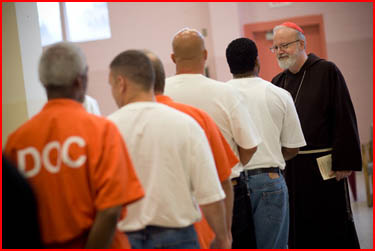
Now, that does not gainsay our lack of preparedness to deal with the people whose mental health problems have put them on the street. That is another problem, but I was certainly impressed by the great respect that the judge has for the people that she serves there. She also talked about John Hinckley, Jr. who was involved in the assassination attempt against President Ronald Regan. She said that the testimony of his parents indicated how, from his childhood, he had mental problems that isolated him from the community. It was so obvious that he was very mentally ill and yet the reaction to the case was for legislatures to change the laws to make it all the more difficult for someone to plead insanity, she said.
Another man who worked at the hospital also talked about a girl who had been stalking some famous television personality and the papers treated it with such levity, calling her a “crazy.” The man said that in interviews, the parents talked about how this young woman had been the valedictorian of her high school and had been such an outstanding student and daughter. They also talked about how she later became schizophrenic, began stalking this man and eventually ended up taking her own life.
There is such tragedy behind these stories, and I was moved to see a whole hospital full of people whose lives have been so damaged. I know the suffering that it causes not only them, but their families and the communities that they come from.
I worked as a prison chaplain for two years when I was a young friar, and it has always been a ministry that I have found to be a great grace. Jesus said, “I was in prison and you visited Me,” and we know that when we go to prison, we do find Christ there. I am very grateful to Deacon Bill Kane, director of the Office for Prison Ministry, and all of those in the archdiocese who are involved in this ministry. We have many religious, deacons, priests and lay people, particularly Cursillistas, who are giving retreats in the prisons and doing wonderful ministry there, helping people to find their way back to God.
– – –
On Thursday I had the pleasure of having lunch with my Capuchin brother, Father Simeon Gallagher.
He travels all over the country to preach and give parish missions and he has given many here in the archdiocese.
He happened to be here this week, so it was wonderful to have a chance to spend some time and speak with him. We were in the seminary together.
– – –
On Thursday evening, I traveled to Marshfield to a home which Msgr. Cornelius McRae and three other priests purchased together many years ago.
Every year Msgr. McRae invites Archbishop Hughes of New Orleans (who is, as most know, originally from Boston) to the house for week or so of vacation.
This was the week of the archbishop’s annual visit, so they asked me to join them for dinner.
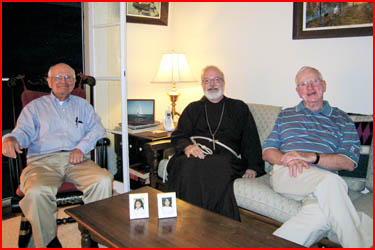
Archbishop Hughes (on the left) Msgr. McRae and I relaxing in Marshfield
During the evening, we had a chance to hear from Archbishop Hughes about the rebuilding effort in his archdiocese in the wake of Hurricane Katrina.
The archbishop noted that the early French Catholic settlers of the area were very wise and built on high ground. For this reason the cathedral, along with many other historic structures in the city escaped with relatively little damage. We are grateful for that.
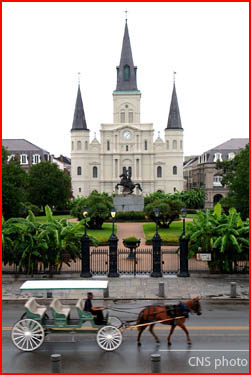
The cathedral of New Orleans
It was also very edifying to hear the stories of the many ways the people, priests and staff of the archdiocese worked to meet the needs of the people of New Orleans in the hurricane’s aftermath: how they worked to find food, clothing and shelter for all those affected by the storm.
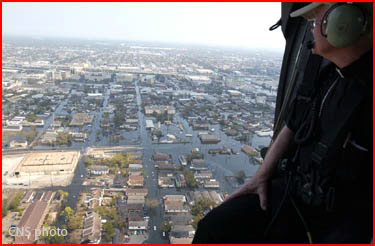
Archbishop Hughes in a helicopter September 2005, surveying the flood damage after Hurricane Katrina
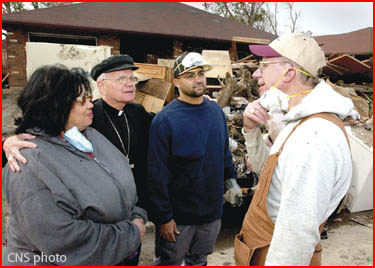
Bishop Hughes made a great effort to understand, first-hand, the needs of his people following the flooding
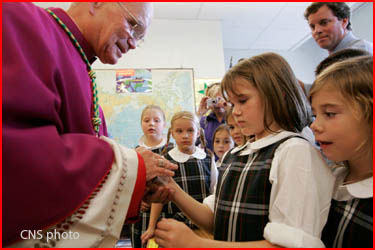
Archbishop Hughes worked not only to meet the physical needs of his people but their spiritual needs as well. Of course, following the hurricane the vast majority of the population fled the area. I was very pleased to learn that wherever there was a large concentration of refugees from New Orleans, the archbishop sent a priest to minister to them.
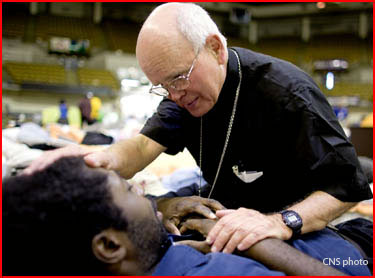
Archbishop Hughes giving a blessing to a New Orleans evacuee at a Red Cross shelter in Baton Rouge
The work of the archbishop and those of the Archdiocese of New Orleans was — and continues to be — truly heroic.
– – –
For my photo of the week I have chosen this photo of a carving given to me by Bishop Stock and is a typical handicraft of the tribal region in India. It was a wonderful gift and I am pleased to have had the opportunity to meet the bishop.
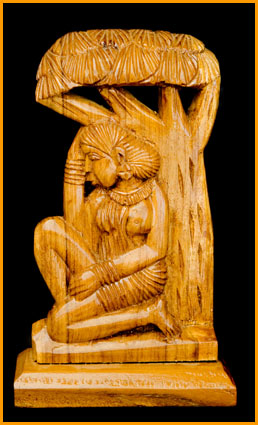
Until next week, a blessed and restful summer week to you all!
– Cardinal Seán
